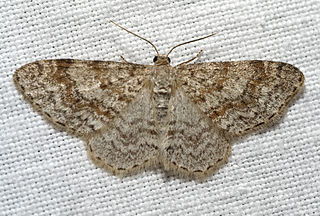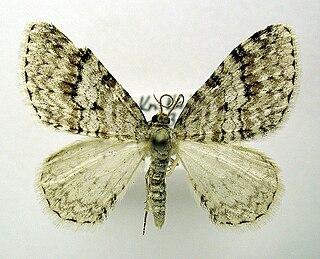
Blomer's rivulet is a species of the family Geometridae of moths, in the subfamily Larentiinae which includes the carpet moth and pugs.

Larentiinae is a subfamily of moths containing roughly 5,800 species that occur mostly in the temperate regions of the world. They are generally considered a subfamily of the geometer moth family (Geometridae) and are divided into a few large or good-sized tribes, and numerous very small or even monotypic ones which might not always be valid. Well-known members are the "pug moths" of the Eupitheciini and the "carpets", mainly of the Cidariini and Xanthorhoini. The subfamily was described by Philogène Auguste Joseph Duponchel in 1845.
Nomenia is a genus of moths in the family Geometridae erected by Richard F. Pearsall in 1905. The genus was previously treated as a junior synonym of Venusia.

Venusia is a genus of moths in the family Geometridae erected by John Curtis in 1839.

Venusia cambrica, the Welsh wave, is a moth of the family Geometridae. It is found in Europe, western and central Siberia, Altai, Transbaikalia, the Russian Far East, the Korean Peninsula, Japan and in North America, where it can be found across Canada from Newfoundland and Labrador to British Columbia, south in the west to California, south in the east to Georgia.
Hydrelia aurantiaca is a moth in the family Geometridae first described by George Hampson in 1903. It is found in China and Nepal.
Venusia albinea is a moth in the family Geometridae first described by Louis Beethoven Prout in 1938. It is found in Pakistan.

Nomenia duodecimlineata is a moth in the family Geometridae first described by Alpheus Spring Packard in 1873. It is found in western North America, from British Columbia to California, Nevada, Arizona and New Mexico.

Venusia comptaria, the brown-shaded carpet moth, is a moth in the family Geometridae. The species was first described by Francis Walker in 1860. It is found in eastern North America, from Florida to Newfoundland, west to Manitoba. The habitat consists of woodlands.
Venusia conisaria is a moth in the family Geometridae first described by George Hampson in 1903. It is found in China, Nepal and India.
'Venusia' distrigaria is a moth in the family Geometridae first described by Jean Baptiste Boisduval in 1833. It is found on Madagascar.
Venusia eucosma is a moth in the family Geometridae first described by Louis Beethoven Prout in 1914. It is found in China.
Venusia laria is a moth in the family Geometridae first described by Charles Oberthür in 1893. It is found in China and Japan.
Venusia lilacina is a moth in the family Geometridae first described by William Warren in 1893. It is found in China, Nepal and India.
Venusia megaspilata is a moth in the family Geometridae first described by William Warren in 1895. It is found in Japan and Korea.
Venusia ochrota is a moth in the family Geometridae first described by George Hampson in 1903. It is found in Nepal and China.
Venusia phasma is a moth in the family Geometridae first described by Arthur Gardiner Butler in 1879. It is found in Japan.
Venusia semistrigata is a moth in the family Geometridae first described by Hugo Theodor Christoph in 1881. It is found in Russia and Japan.
Venusia purpuraria is a moth in the family Geometridae first described by George Hampson in 1895. It is found in India.




